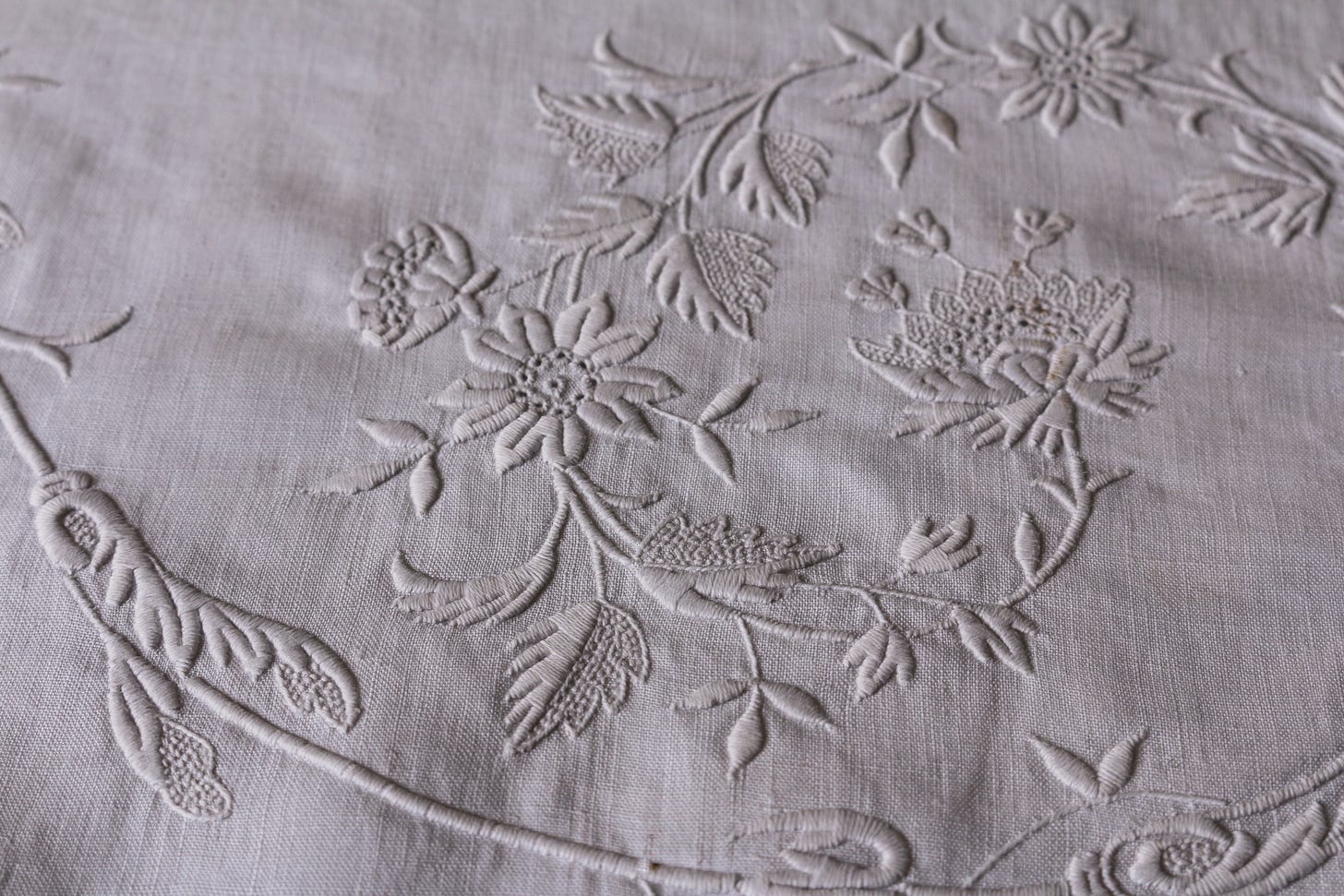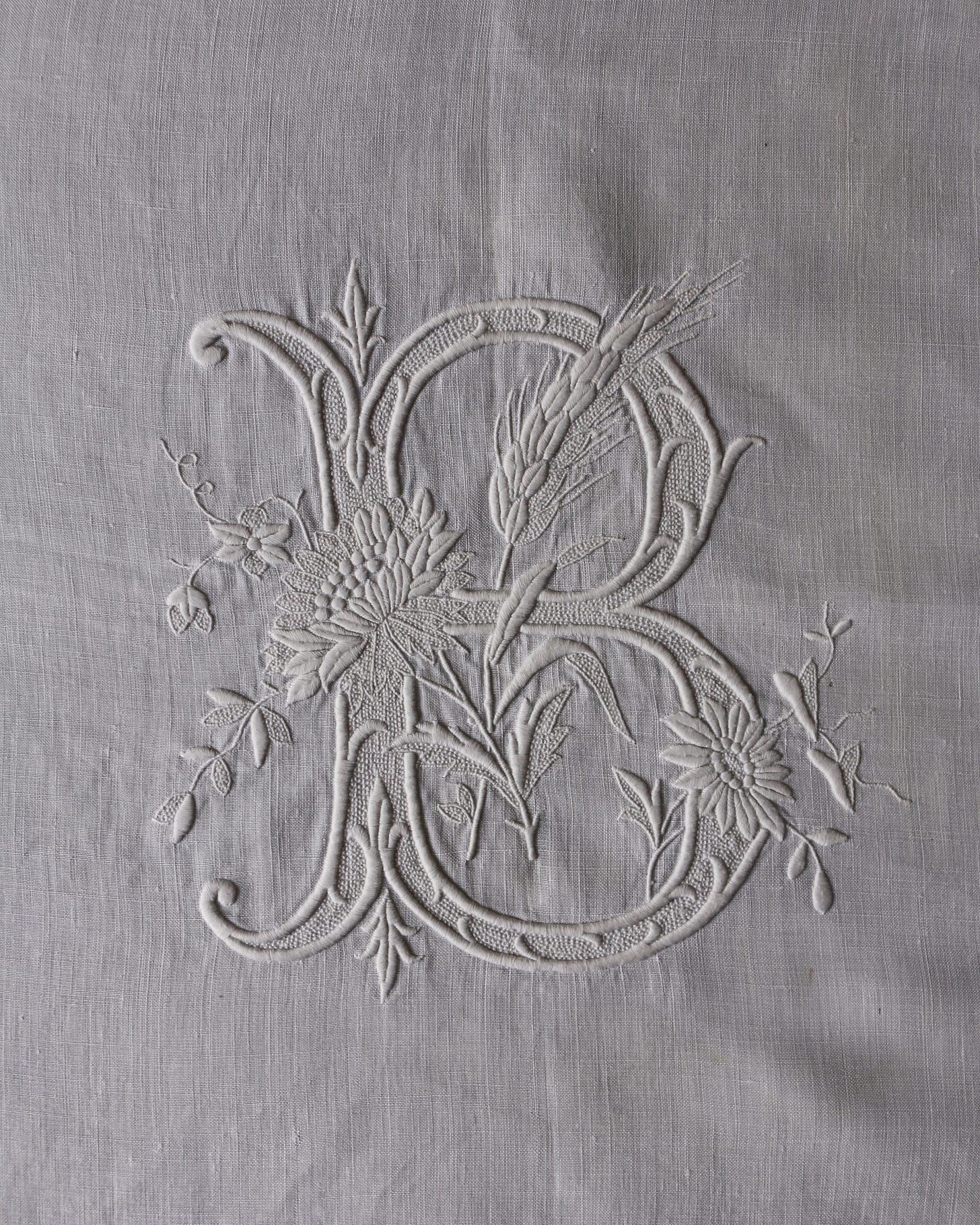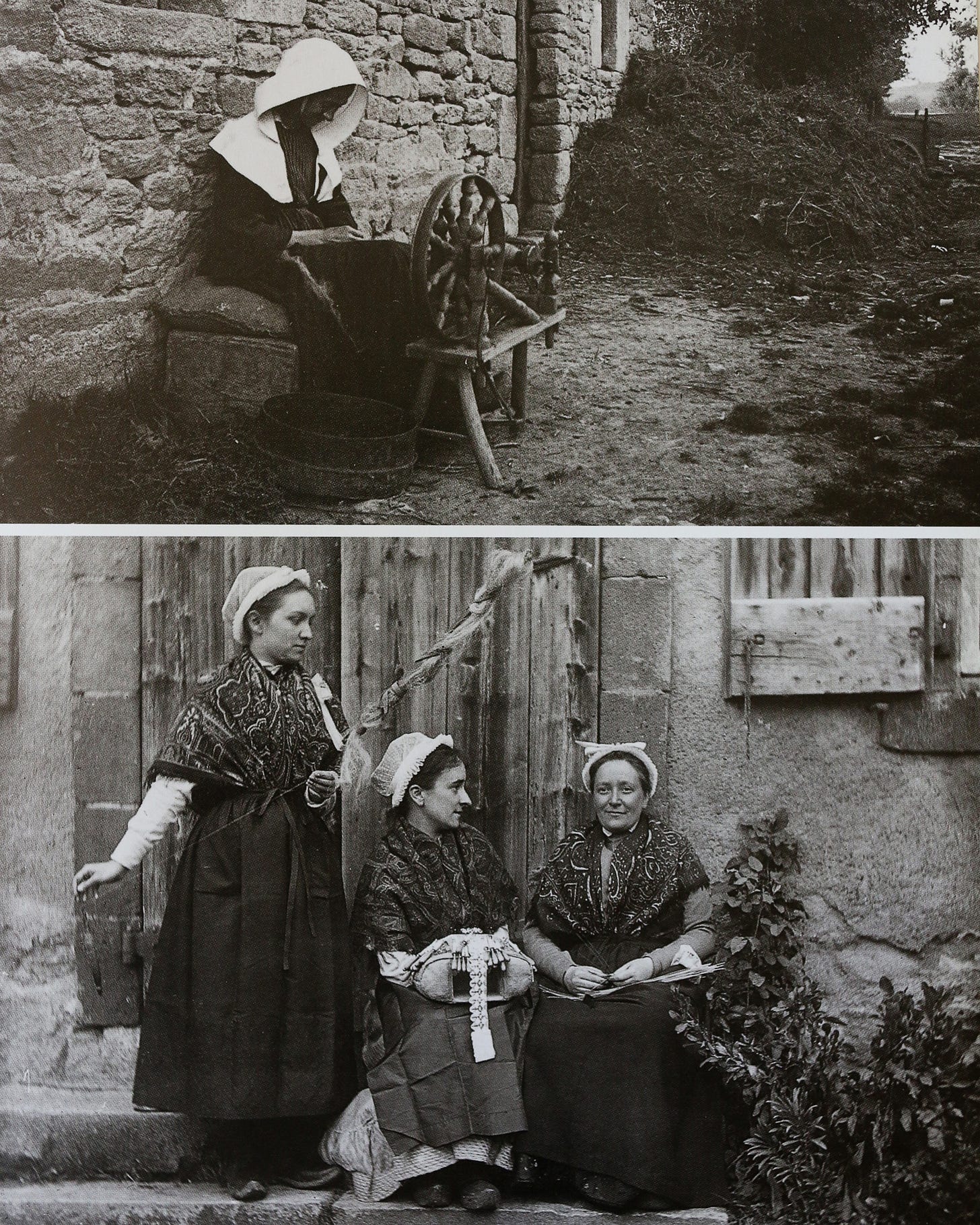This post is a small showcase of the superb embroidery skills of the women of the Touraine and Loire Valley. It is a slightly modified repost from an old blog post I wrote in 2021. I lost most of the original photos so I had to retake some using what examples I have to hand
The region I lived in from the time I arrived in France until December last year was justly famous for its embroidery, amongst other things (silk, hemp and linen being some of those other things.) Historically a very rich area, the Touraine, the area around Chinon and Saumur and the Loire Valley is full of magnificent châteaux, and that is mostly what tourists remember when they come here. But the other thing it is famous for is its superb wine. I didn't get wine until I moved here, because until I moved here I had never tasted wine like it. Opening a bottle of wine here is like opening a vessel of sunlight and a record of rain and earth. This region has centuries of savoir-faire in many earthly products, but for many of those centuries, wine has been one of the main ways rural people have made a living - wine and wheat, hence why the motives of grape vines and wheat sheaves are so common on local textiles, representing as they do abundance, fertility, stability.
But in the mid-19th century, a catastrophe occurred right across this region. Grape rot, caused by an aphid, was brought across the Atlantic from America as trade between the two countries began to open up (here I am paraphrasing Wikipedia where you can read more - go search for The Great French Wine Blight). It caused unbelievable damage right across France, devastating and killing thousands of acres of vineyards. In a region such as this one, so dependent on the grape vines, the outcome was widespread and deep rural poverty and misery.
The rest of this story was told to me by a brocante seller, an older woman named Catherine, who has collected and sold textiles for many decades and who was the first person here to begin telling me about the history of these textiles. It was Catherine who first showed me how to feel for linen in a textile, for example how to tell linen batiste (the finest quality of cloth - the pictures below are on linen batiste and it was the textile of the finest handkerchiefs and of liturgical aubes) from cotton batiste - amongst many other things; but it was also Catherine who made me see, early on in my first year here, that if I immersed myself into understanding the origins and history and techniques of the antique textiles I find here, I would also be well along the way to understanding the history and people of France herself. From then on, I have tried my best to learn what I can about each new piece I handle, sometimes holding onto new things for months - or forever - until I can understand a little of how it was made, what motivation there was to make it, who made it, what it was made from, how it was used. This to me is the interest in these pieces, not just their beauty, but the people and reasons behind them.
So Catherine told me that on the back of this devastating loss of income, many rural families and subsistence farmers were plunged into poverty. In a world before social security, such a failure of plants which were decades or centuries old, was not easy to recover from. And the knock-on effects of all those who made their livings from wine must have been brutal.
Into this terrible situation stepped a gentleman whose name I have not been able to find, but he did exist, because I believe Catherine, who is a genuine Tourangelle (a woman from Tours - in my adopted France I am also a Tourangelle because this is where I started my new life). This nameless gentleman (why am I remembering the name Charles - I have this information in a notebook and of course I cannot find the notebook and if I wait to find the notebook I won't write this post so hey-ho let's call him Charles) - had noted that the women of this region wore exceptionally beautiful coif-caps on which there were lovely, almost mediaeval, motifs of magical flowers and leaves in a decorative and delicate whitework. He decided to promote this embroidery, and to help rural women to develop it further, on other products, which could be sold to people who were not coif-cap wearing rural women, and a cottage industry was born, one in which the women of vineyard farm families had a product that was saleable whilst they struggled to make it out of the devastation.
These two images are of a piece cut from a 19th century coif-cap I sold recently, on finest linen batiste. (Please note I didn’t cut the cap up, I never would, I found it like this)
There are two reasons I believe this story - one is that this type of embroidery became justly famous and was very-much sought after all over France by the late 19th century, and the second is that in other regions, local styles of lacemaking and embroidery which were not promoted and supported by finding new markets disappeared altogether.
This embroidery found a particular new market in decorating the sheets of the wealthy, as well as very fine handkerchiefs termed popularly ‘wedding handkerchiefs’. These items must have cost a mint even back then. I have also found a number of pieces of clothing and underwear - my most favourite pieces are two desperately damaged women’s shirts from around 1870 which I can’t lay my hands on at the moment but which I have shown before. The fineness of the embroidery on some of these pieces is breathtaking - look at the letter B down below. The style of infill using tiny delicate balanced stitches that look like dots is also indicative of Loire Valley embroidery - in fact they are called 'sables de la Loire' - sands of the Loire. You can see this also on that letter ‘B’ below, along with a characteristic wheat sheaf, symbol of prosperity in this region.
This astonishingly fine letter was cut (again not by me) from a worn linen sheet. The forms of the fantastical flowers, the letter shape, and the infill are exceptionally Touraine embroidery
These two images come from a fine cotton corset cover I sold recently. The style of the embroidered leaves with the lengthwise slits is quite common - those slits would have originally had a contrasting silk ribbon threaded through them.
This example shows the embroidered monogramme of a countess, and comes from the area around Saumur c.1870. I can place this very precisely because it was my ex-landlady’s grandmother’s (Claire is currently 88 and she and her sister Genevieve have become something like adopted family and we are going to visit them this weekend if all goes well)
Some more images from the embroidery piece that the first image came from - once again cut from a sheet and once again I must stress not cut by me! I never cut up intact sheets unless they are really super unexceptional or damaged beyond repair, and the only reason I would ever cut the embroidery off a sheet is if the body of the sheet was beyond saving. Although, to be honest, almost certainly this is what has happened here!
I would imagine that this cottage industry, much like many others, was crippled by the presence and after-effects of the First World War in this region and on France's economy, and dealt the death-blow by the Second World War and the subsequent exodus from subsistence farming and towards manufacture that the toll of these two wars forced on France.
Please enjoy looking at these pieces, and remember the women who made these exquisite stitches - not heiresses sitting by a chateau window stitching their dowery textiles, but rural women sitting outside their small houses (often houses in caves dug into the side of the hills in the Touraine and Saumur regions) in the open light in order to see the fine work they were doing, spread over their clean aprons, working to feed their families.
The last photos are taken from a great book I came across in the brocante (everything I own pretty much now comes from the brocante!) which gathers together photographs from the 19th and early 20th centuries, documenting the last of France's extraordinary history of peasant agriculture and artisanship before the two world wars tore everything to bits. It's called 'Gens de la terre: La France rurale 1890-1940', by Jean-Luc Mayaud if you wish to track it down. These two pictures are not from the Touraine and they are showing spinning rather than embroidery - I couldn't find any from the Loire Valley, so the top one is from Britanny in 1910, and the bottom is from Puy-de-Dome in 1899, but they show a similar scene of rural women working outside their small, dark cottages to make beautiful textiles.















Oh my, what beautiful work - thank you for the pleasure of seeing it. Love the photo of the women in what looks like Paisley type shawls too, that was interesting. I do enjoy your newsletters, I always learn new things, thank you so much!
Thank you for another fascinating insight into the background of these beautiful textiles, which helps me to enjoy looking at them all the more. Have a nice weekend with your adopted French family.